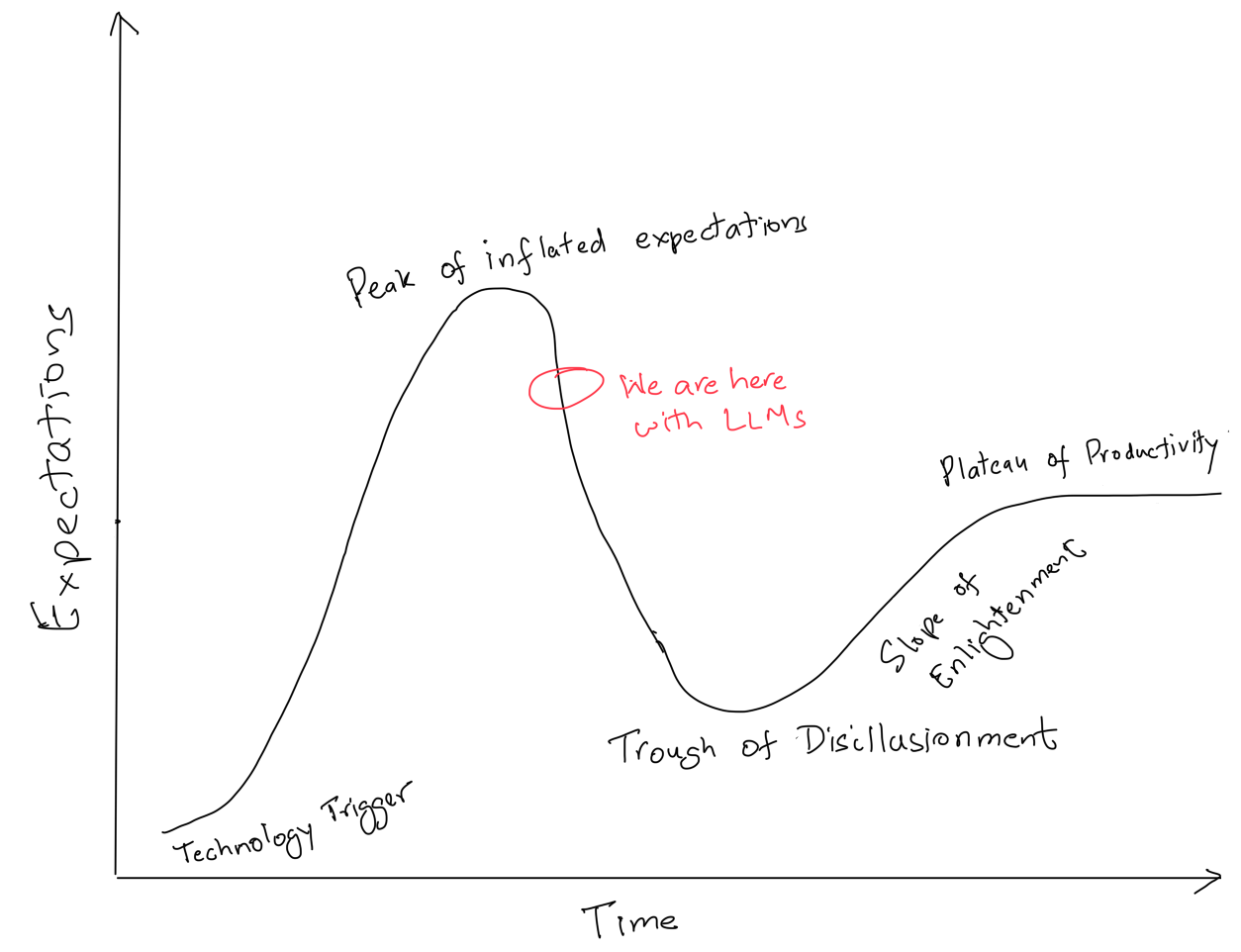And why that’s a good thing!
I believe that, in the long term, LLMs will revolutionize our society just as the Internet and mobile phones have in the past. However, in the short term, LLM technology, like all revolutionary technologies, will go through the trough of disillusionment.
Garter Hype Cycle
Gartner’s famous hype cycle, proven by past technology innovations, illustrates the journey of a revolutionary technology from introduction to mass adoption.

Olga Tarkovskiy, CC BY-SA 3.0 via Wikimedia Commons
When a revolutionary technology is first introduced, it often leads to a peak of inflated expectations. People expect it to achieve extraordinary things that it simply cannot (at least not yet). Eventually, as people realize these limitations, they become disillusioned, leading to the trough of disillusionment. Expectations are lowered, and many abandon the new technology. However, as the technology begins to meet these more realistic expectations and as people learn how to best utilize it (slope of enlightenment), we reach the plateau of productivity, where the technology becomes commonplace.
Peak of Inflated Expectations

Internet: In his 1995 book, The Road Ahead, Bill Gates predicted after the invention of the Internet that “banks are dinosaurs… We can bypass them.” While online banking and fintech innovations have significantly transformed the banking industry, traditional banks have adapted and remain central to the financial system.
LLMs Today: LLM technology is currently at a peak of inflated expectations. People expect it to eliminate jobs, solve every problem, and fundamentally change corporate culture.
Having worked extensively with LLM technology over the past year and understanding the dynamics of mass adoption from decades of experience, I believe our expectations are inflated beyond what the LLM technology can deliver today.
It’s one thing for a technology to work in a demo by an individual. It’s quite another for it to work consistently for customers in real-world interactions.
Obstacles to wide-spread adoption of LLMs

LLM technology can solve simple use cases, but there are many barriers to solving the complex use cases that people currently believe it can handle:
- Hallucinations: Hallucinations are inherent to LLM technology and worsen as the use cases become more complex. Contrary to the promises of software companies, there is no way to eliminate hallucinations from LLM technology. Instead, we need to develop tools and technologies to minimize them (e.g., AI agents, our 8-step framework). It will take time to develop these tools and technologies to a point where we can minimize hallucinations for complex use cases.
- Data Format: Much of the data within companies is not in the right format for LLMs to process. Most company data exists in tabular form (SQL databases), and LLMs, trained on natural language, struggle with this. Data needs to be transformed into textual format for LLMs to handle it effectively, a non-trivial task that requires significant investment.
- UI and Workflows: Most user interfaces and workflows in companies are very rigid. The real value of LLMs comes when they control the workflow rather than just being called within a rigid workflow.
- Reimagining Processes: Revenue improvement doesn’t come from merely speeding up existing processes but from reimagining how we do things today. The current focus is largely on speeding up existing processes, which misses the true potential of LLMs.
Trough of Disillusionment

Internet: In 1998, economist Paul Krugman predicted that “by 2005 or so, it will become clear that the Internet’s impact on the economy has been no greater than the fax machine’s.” Instead the Internet has profoundly impacted the global economy, transforming industries, creating new business models, and significantly boosting productivity.
LLMs Tomorrow: Given the impossible expectations, I expect that people will soon feel disillusioned as LLMs fail to live up to these lofty expectations. We’re already seeing this happen. In a recent survey by Lucidworks, only 63% of companies are planning to increase AI investments compared to 93% in 2023.
Companies focusing on simple use cases will succeed (e.g., Apple doesn’t need complex AI, just a compelling reason for users to upgrade).
Companies attempting complex use cases (replacing humans with AI) will likely fail, leading to a perception that LLM technology is not as good as initially thought. Thankfully, this will lower expectations to a more practical level.
Slope of Enlightenment

By working on simple use cases, we will learn how to improve and control LLM technology. We will build tools and technologies around LLMs, format our data correctly, evolve our corporate culture, and identify necessary changes to our processes and businesses to fully leverage LLM technology.
Plateau of Productivity

Finally, we will achieve the material and lasting benefits of LLMs. We will re-imagine our processes to take advantage of the tremendous power of LLMs while inventing tools and technologies to turn LLMs from a technology to a solution.
What Should You Do Today?

If LLM technology is heading towards a trough of disillusionment, here are steps you should take:
- Focus on Simple Use Cases: Instead of solving huge problems, focus on simpler ones. The key is to gain experience that will be valuable in the future.
- Evolve Your Data Platform: Make your data platform LLM-compatible by moving to knowledge stores where data is stored and searched in plain language.
- Evolve User Interfaces and Workflows: Make your UIs and workflows dynamic, enabling them to be controlled by the LLM rather than controlling the LLM.
- Understand Business Fundamentals: Focus on understanding the fundamentals of what makes your business succeed or fail. Don’t just try to speed up current processes; design new processes that take advantage of LLMs’ power.
Taking these steps can prepare you for the coming trough of disillusionment, enabling you to successfully navigate to the plateau of productivity.
